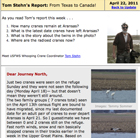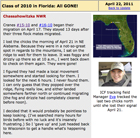Excitement grows as the annual cycle continues. The first Western cranes have reached their Canadian nesting grounds and Eastern cranes have 16 nests. This photo makes us wonder: how many eggs does it take to make another Whooping crane egg? Next time: baby chicks!
Today's Report Includes:
- News: Migration Map and Field Reports
- Wisconsin Nests: Now 16
- Last Year's Young: Off on Their Own
- Chicks: Coming Soon!
- Annual Evaluation: Please Share Your Thoughts

Image: Vickie
Henderson
How
many?
 |
||
|
Data /Map/Finish
Line |
Latest
News: Western Flock On April 25th, the first radioed crane had arrived on the nesting grounds in Wood Buffalo National Park. Nest searches there will begin May 20. More |
Latest
News: Eastern flock |
With nests, each season you win a few and lose a few. In past seasons, black flies have pestered the cranes so badly that they couldn't remain on their nests. This year, the cooler weather has prevented black flies hatching yet. Here's the latest:
The first birds to arrive are the experienced breeders from previous years, while the last birds to arrive are subadults. The subadults are those birds that are 1 or 2 years of age along with a few 3 year olds that have not begun to nest. The birds usually begin nesting around 5 years of age, but can nest as early as age 3.
Successful breeders from last year will have last year's "crane kid" with them on migration. The young birds will stay with their parents for most (or all) of the spring migration. But then they will separate. Here's how the separation may happen:
In Saskatchewan, or sometimes further south, the adults will begin the process of separation. This begins with the adults, usually the male, going through bouts of chasing the young from the group and then tolerating the youngster for a while before chasing it away again. After several days, the young crane will get used to being on its own and will eventually separate permanently from its parents.
If the youngster happens to stay with the parents until they arrive on the breeding grounds it will be chased away at that point, just as if it were some other intruding bird in the territory. The adults will soon raise the next generation.
Will you take a few minutes to complete our Year-end Evaluation? With your help, we can document Journey North's reach, impact and value. We need comments like yours to keep the program going and growing.
-
Annual Evaluation: Please Share Your Thoughts
Research Question: How many Whooping crane eggs does it take to make another Whooping crane egg? (The answer is not as simple as it seems.) What factors might affect breeding success?
- Lesson: How Many Whooping Crane Eggs Does it Take to make Another Whooping Crane Egg?
- Crane Conservation, Art, and More: Supplementary Resources
The next Whooping Crane Migration Update Will Be Posted on May 13, 2011.









